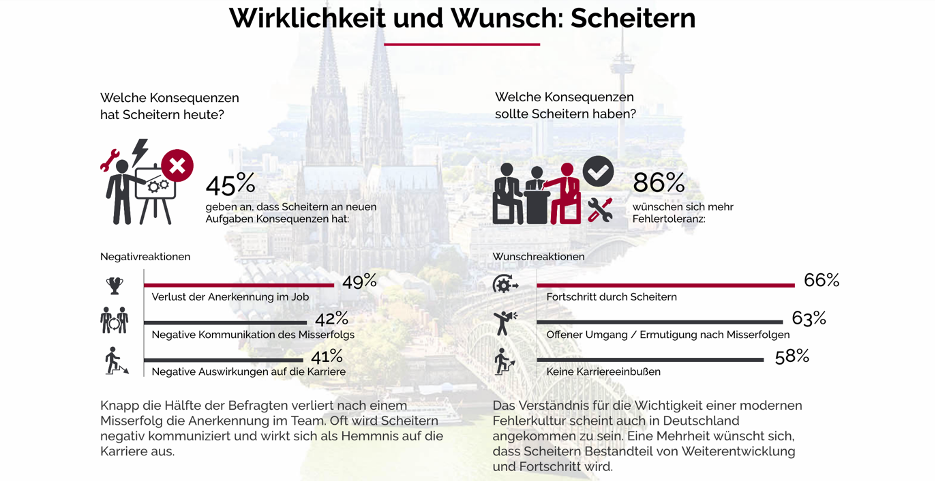
Failure is a matter for the boss
Where there's planing, there's chipping. A well-known saying that takes on new relevance in times of digital change - in the form of the widely propagated error culture. After all, change requires creativity, innovation and, above all, the courage to make mistakes. Establishing a positive error culture in the company is therefore a key management task.
Germany calls itself "The Land of Ideas". We are also world-renowned for perfectionism and top quality. This is what makes our economy so unique. Even at school, we learn that mistakes bring bad marks and a scolding from our parents.
In the world of work, it is best not to make any mistakes, as this could have far-reaching consequences for the company. This striving for perfectionism does little to prepare us for the digital future. "Those who plan for a long time and want to rule out every imponderable will miss out on important trends, market entries or changing customer needs, "1 says Luuk Houtepen, Director Business Development at the international HR consultancy SThree. In his opinion, an intelligent error culture would be an important survival strategy for a company.
Zero-defect tolerance was yesterday?
In the minds of most bosses, mistakes still mean a fiasco that must be avoided at all costs. Managers are afraid to take risks - after all, there are also professional fields in which mistakes would be fatal.
Established companies in particular have a lot at stake, so it is better to take fewer risks. The frequently cited "fail fast" principle works particularly well where the costs caused by errors are low, structures are less complex and hierarchies are not yet rigid: for example, in smaller start-up companies that primarily thrive on reacting creatively and agilely to market situations.
"Large organizations with established customer relationships, grown partnerships and a high degree of responsibility for their own workforce, on the other hand, put one thing above all at risk: trust," says change management expert Sören Krüger in an article on error culture.2 In unpredictable markets, dealing with errors is always a balancing act, he says. Many managers prefer to take the safe route and pursue a zero-error tolerance. However, there is not just black or white, but various ways to embrace a culture of error.
3 ways to deal with errors correctly
It always pays to deal with mistakes confidently, because nobody makes them on purpose. Avoiding mistakes at all costs is not an option. What is needed are solution-oriented strategies to deal constructively with mistakes.
A constructive error culture is cultivated at pme Familienservice . CEO Alexa Ahmad says: "Almost everyone is embarrassed by mistakes. You can't let that paralyze you. I have no problem if someone comes to me and says: 'I think something went wrong'". However, it is difficult when team members conceal or cover up mistakes. "That almost always goes wrong, violates trust and deprives us of the chance to do better next time. Often a problem only becomes big because team members don't 'speak up'. If you admit mistakes, you can iron them out," says Ahmad.
Error culture starts with communication. This includes managers showing their teams that mistakes are not desirable, but - with certain limitations (see list below) - are not a disaster either. They are part of the creative process and pave the way for development.
Of course, there are big differences. Formally celebrating mistakes and always seeing the positive in them can be beneficial and instructive in a complex environment with many uncertainties. However, where security is paramount, it can have more disadvantages. According to the survey "This is how Germany works", 86% of respondents would at least like to see a higher tolerance for errors.3 Implementing an error culture therefore does not mean completely restructuring the company. A partial error culture is particularly suitable for larger companies.

1. fault tolerance
A culture of error is not actively promoted, but it is perfectly okay for mistakes to happen. Employees are encouraged to own up to their mistakes.
2. openness to errors
Openness to mistakes is perfect for companies or departments where there are few standards and they are required to try things out and be creative - for example in the digital sector.
3. error prevention
Of course, there are areas in companies where errors should be avoided as far as possible, for example in accounting, in the airport tower or in quality control. However, there are more control mechanisms here.
Taking joint responsibility for successes and failures
We know that: Everyone makes mistakes - it's how you deal with them that counts. Alexa Ahmad: "I think everyone has a right to make mistakes, but not the same mistake twice or three times. It's better to try something new and make other mistakes that we can learn from. My tip: talk to each other, nobody is infallible".
This is where the management level comes into play. Only if senior management establishes and lives an error culture that is adapted to the company will this have a positive impact on the company's growth.
Here, it is just as important to give constructive feedback as it is to dissolve firmly anchored basic attitudes that prevent a culture of error. According to a survey by Statista on "What makes a good manager "4, 60 percent of employees would like to see a culture of error. How can a manager set a good example? Among other things, by communicating their own mistakes positively and openly, trusting in the abilities of their team members and motivating them to tackle new tasks with courage. And by taking the time to learn from mistakes.
Read our article: "9 tips on how managers can establish an error culture in the company" to find out how you as a manager can successfully implement an error culture in the company.
About the pme Familienservice
On behalf of more than 900 employers, the pme Familienservice Group supports employees in achieving a successful work-life balance and being able to work with a clear head.
Sources:
1 https://www.marconomy.de/wieso-scheitern-gut-fuer-das-geschaeft-sein-kann-a-728814
2 https://medium.com/deutsch/warum-eine-fehlerkultur-allein-nicht-die-antwort-sein-kann-9d70caf4a90a
3 https://so-arbeitet-deutschland.com/scheitern-innovation
4 https://de.statista.com/infografik/10710/was-eine-gute-fuehrungskraft-ausmacht





